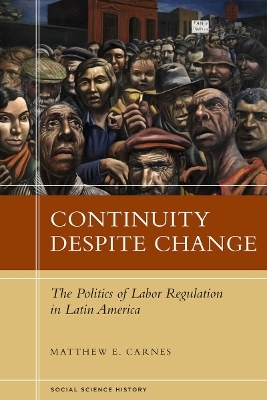
Continuity Despite Change
Stanford University Press (Verlag)
978-0-8047-8943-1 (ISBN)
As the dust settles on nearly three decades of economic reform in Latin America, one of the most fundamental economic policy areas has changed far less than expected: labor regulation. To date, Latin America's labor laws remain both rigidly protective and remarkably diverse. Continuity Despite Change develops a new theoretical framework for understanding labor laws and their change through time, beginning by conceptualizing labor laws as comprehensive systems or "regimes." In this context, Matthew Carnes demonstrates that the reform measures introduced in the 1980s and 1990s have only marginally modified the labor laws from decades earlier. To explain this continuity, he argues that labor law development is constrained by long-term economic conditions and labor market institutions. He points specifically to two key factors—the distribution of worker skill levels and the organizational capacity of workers.
Carnes presents cross-national statistical evidence from the eighteen major Latin American economies to show that the theory holds for the decades from the 1980s to the 2000s, a period in which many countries grappled with proposed changes to their labor laws. He then offers theoretically grounded narratives to explain the different labor law configurations and reform paths of Chile, Peru, and Argentina. His findings push for a rethinking of the impact of globalization on labor regulation, as economic and political institutions governing labor have proven to be more resilient than earlier studies have suggested.
Matthew E. Carnes is Assistant Professor in the Department of Government at Georgetown University.
Contents and AbstractsIntroduction: Introduction: Continuity Despite Change chapter abstractThis chapter describes the puzzling persistence of extremely protective labor laws in Latin America, in spite of significant competitive pressures from globalization and a series of attempted reforms in the 1980s and 1990s. It notes that labor laws have been more resistant to reform than any other area of economic policy, and motivates the rest of the book by explaining the importance of labor law as both a dependent variable and independent variable, outlining the history of study of Latin American labor laws, and describing the implications of different forms of labor regulation for outcomes as diverse as economic inequality and political participation. It concludes with an overview of the remaining chapters of the book.
1Explaining Enduring Labor Codes in Developing Countries: Skill Distributions and the Organizational Capacity of Labor chapter abstractThis chapter builds a general theory of labor regulation. It describes the labor law "policy space" and articulates a typology of four hypothetical labor law "regimes." It traces the origins to these regimes to two explanatory variables: (1) the distribution of skills in the economy, and (2) the ability of labor to organize to represent its interests. It argues that these factors played a critical role in shaping the earliest state efforts at regulating labor relations in Latin America, beginning in the late 1800s and early 1900s. It then develops a series of arguments about how skill distributions and labor organization functioned under successive waves of economic policy. During industrialization (as occurred in the middle of the twentieth century), they shaped the expansion of coverage of labor regulation. And under globalization (at the turn of the millennium), they constrained – and in many cases, severely limited – the extent of liberalizing reforms.
2Using Multiple Methods to Understand Labor Law Development in Latin America chapter abstractThis chapter describes the two-pronged methodological approach employed in the remainder of the book. First, it describes the original dataset assembled for the quantitative analysis – a comparative operationalization of 23 labor law features from 18 countries – and details the strengths and weaknesses implied in a quantitative research strategy. Next, it describes the qualitative, "analytic narrative" approach employed in the case studies. It discusses the selection criteria for choosing Chile, Peru, and Argentina as exemplary cases, and provides a preliminary comparison of their relative skill levels and labor organization throughout the twentieth century.
3Latin American Labor Laws in Comparative Perspective chapter abstractThis chapter employs an original cross-national dataset of individual and collective labor regulations to chart the range of variation in labor laws within Latin America during the 1980-2005 period. Econometric analysis finds that skill levels and organizational capacity are consistently correlated with differences in labor regulation "regimes" in recent decades. In addition, the chapter tests alternative hypotheses present in the literature, finding that government partisanship has important effects both through its historical legacies and through the reforms proposed by sitting governments.
4Fragmented Individualism: Professional Labor Regulation in Chile chapter abstractThis chapter examines Chile as an example of a "professional" labor law regime, characterized by laws that strongly protect individual labor relations but fragmented and weaken collective labor relations and unions. It traces the roots of Chile's early labor laws to patterns of labor recruitment in Chile's geographically isolated mines, its ports, and its urban professional sectors. It then shows how subsequent periods of economic development further fragmented coordination across labor unions, while preserving significant individual protections for a reduced share of the workforce in skilled or critical economic sectors.
5Contradictions, Division, and Competition: Encompassing Labor Regulation in Peru chapter abstractThis chapter examines Peru as an example of an "encompassing" labor law regime, which offers low levels of individual worker protections but facilitates independent union organization and activity. It argues that the lower level of skills in the Peruvian economy made organization around issues of individual contracting difficult. Further, frequent periods of authoritarian rule and weak ties between workers and political parties offered few opportunities for the advancement of labor's collective interests. As a result, during the globalization period, Peru has undermined even the weak labor laws it had developed, consigning an ever-greater proportion of the population to work without legal protection.
6Integration and Incorporation: Corporatist Labor Regulation in Argentina chapter abstractThis chapter examines Argentina as an example of a "corporatist" labor law regime, with high levels of both individual and collective labor regulations. It argues that the country's early labor market conditions – including significant immigration from Europe and relatively high education and skill levels – led to more extensive initial legal protections. In later decades, labor law became a vehicle for incorporating a broad swath of workers into the movement surrounding Perón and the party that has continued his legacy. It concludes by contending that in recent years, strong ties between the Peronist party and organized workers account for the relatively meager liberalization that has occurred.
Conclusion: Conclusion: Politics and Labor Regulation in Latin America chapter abstractThis brief chapter accomplishes three tasks. First, it summarizes the book's major contributions, highlighting how its theoretical approach and long historical perspective permit a better understanding of the surprising stability in labor codes in Latin America, despite efforts and pressures for reform. Second, it discusses the implications of the book's findings for study of Latin American social policy, political economy, and corporatism. It concludes by suggesting future avenues for research on labor laws in the region, noting the need for more extensive study of variation in compliance and enforcement of legal regimes.
| Erscheint lt. Verlag | 13.8.2014 |
|---|---|
| Reihe/Serie | Social Science History |
| Zusatzinfo | 14 tables, 22 figures |
| Verlagsort | Palo Alto |
| Sprache | englisch |
| Maße | 152 x 229 mm |
| Gewicht | 476 g |
| Themenwelt | Geisteswissenschaften ► Geschichte ► Regional- / Ländergeschichte |
| Recht / Steuern ► Arbeits- / Sozialrecht ► Arbeitsrecht | |
| Recht / Steuern ► EU / Internationales Recht | |
| Wirtschaft ► Volkswirtschaftslehre ► Makroökonomie | |
| ISBN-10 | 0-8047-8943-6 / 0804789436 |
| ISBN-13 | 978-0-8047-8943-1 / 9780804789431 |
| Zustand | Neuware |
| Haben Sie eine Frage zum Produkt? |
aus dem Bereich


